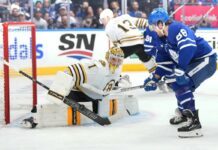The Maple Leafs entered this game with a number of lineup changes coming off last night’s loss in LA.
William Nylander was moved to center, Calle Jarnkrok was paired up with John Tavares, and NAK was swapped for ZAR on the fourth line, but as usual, the top line remained untouched. That decision ended up foreshadowing the game’s events to some degree.
After building a multi-goal lead in the third period against the worst team in the league, the Leafs coughed it up and lost in overtime to end their road trip with one win in five games (1-2-2). Returning home to Toronto, if this keeps up much longer, it’s going to get ugly.
Your game in 10:
1. Considering the scrutiny the team has been under, the coaching staff dramatically changing the lines, and the quality of the opponent, I thought the Leafs’ first shifts were tentative. Anaheim generated the first two shots of the game and an early scoring chance in the slot that Adam Henrique ripped wide. It was eerily reminiscent of the type of starts this Leafs core usually comes out with during big/playoff games. Unlike those games, though, this Anaheim team is really bad.
Shortly after, Auston Matthews went on a 2v1 and rang it off the bar. The Leafs then drew a penalty and scored.
William Nylander, who is off to a strong start to the season, was streaking down the wing with the puck and found Matthews all alone in the slot, which is an easy finish for him. The Leafs have been falling behind in games and playing catch-up during their slow start. Their losses hadn’t been the result of blown leads to this point. An early lead in this game allowed them to settle in.
TONE TIME! ⏰ pic.twitter.com/YYs1nsDhR2
— Toronto Maple Leafs (@MapleLeafs) October 31, 2022
2. The Leafs did start carrying play afterward, and they should have scored another goal after a Calle Jarnkrok pass attempt gave Alex Kerfoot what should have been a tap-in. Instead, he had his hands up in the air celebrating as the puck hit the post. The puck went the other way, Mitch Marner committed a careless turnover in his own end, Anaheim quickly touched the puck to the slot, and Jakob Silfverberg made no mistake.
There’s not much to say if you’re the goalie or the defense there. It’s a bad giveaway, and Silfverberg is a legitimate goal-scorer in the league. Not many goalies are going to stop him there on a bang-bang play in front.
And then there’s the matter of the premature goal celebration, which is something you’d expect in minor hockey or a shinny game. This is the National Hockey League. You make sure the puck goes in when there’s a goalie in the net and the game is tied.
3. Anaheim is a really bad hockey team, and we can’t write these notes without acknowledging it explicitly. They came into this game dead last in the league with the lowest goals for per game average in the league and the third-worst goals against per game. Both special teams rank second worst in the league.
All told, a team doesn’t get much worse than that. They play with no structure. The neutral zone was wide open all night. You’d think it might be the type of confidence booster the Leafs needed – an opportunity to touch the puck a lot and create chances. And in the first period, the Leafs were credited with 15 shots on goal in the first as well as nine high-danger scoring chances according to Natural Stat Trick.
4. The Leafs’ second goal of the first period is a great example. Filip Kral – who has been solid in his first NHL call-up – hesitated while carrying the puck up ice and fell down. He chipped it up the wall to avoid further danger. Nick Robertson chipped it again, and William Nylander used his speed to get onto the puck first and knock it over to a streaking Denis Malgin, who went in on a breakaway and scored with a great forehand-backhand-top shelf move.
We’ve long talked about the merits of Nylander at center, and while a game against the Ducks isn’t going to prove much either way, part of the logic is utilizing his speed and skill up the middle of the ice – the most dangerous part of the rink – rather than confining him to one wall. On that play, he won a race with his speed and Malgin made no mistake.
Malgin has been productive and has looked good against the weaker teams. I don’t think there’s much question about whether he can play in the league. If he was on a bottom feeder like Anaheim, he could easily play all season and produce offensively similar to Alex Barabanov in San Jose. The question with the Leafs is whether he can carve out a full-time role here.
MALGY'S MITTS 🤢 pic.twitter.com/mBDnYOAPO2
— Toronto Maple Leafs (@MapleLeafs) October 31, 2022
5. Armed with a lead entering the second period, it felt like the Leafs would take control of the game. After they went to an early power play on a high-sticking penalty, there was a commotion in front of the net on the power play, and the puck eventually made its way to Auston Matthews in the slot with the goalie down, but he couldn’t get it through all the traffic and into the net.
Matthews’ line put together some dominant shifts in the second – controlling play, hemming Anaheim in their zone multiple times – but was unable to cap off sequences with goals or even prime scoring chances. Matthews recorded four shots on net, a goal, and a post through two periods in the game.
6. As the period progressed, Anaheim started to generate more chances and actually carried play in the final five minutes. That included a number of grade-A scoring chances. Erik Kallgren was really good.
Chances for Anaheim included a clean one-timer near the faceoff circle, a wraparound attempt that Rasmus Sandin appeared to save, a clean 3v2 that Morgan Rielly was able to stop, and a clear breakaway for Derek Grant that ended with a save and a penalty on Auston Matthews after Kral again was nervous with the puck (the first occasion resulted in a goal for the Leafs, at least).
Overall, shots on net in the period were 14-7 in favour of Anaheim. They tilted the ice as it went along, and while the Leafs ultimately survived, it was concerning to see such a poor team impose itself on the Leafs in a tight game.
7. The penalty on the Derek Grant breakaway turned out to be a blessing to start the season. TJ Brodie ripped a beautiful outlet pass through the middle of the ice while shorthanded to Calle Jankrok, creating a 2v1 with Alex Kerfoot. John Klingberg played it like he was waiting for the trade deadline on his expiring contract. Kerfoot made a good play to sell the shot, which had John Gibson fully fooled and gave Jarnkrok an empty net to finish into.
JÄRNY WITH THE SHORTY!! 🚨 pic.twitter.com/qlW2WLnp0r
— Toronto Maple Leafs (@MapleLeafs) October 31, 2022
Since Anaheim’s first game of the season, they have been outscored 2-0 while on the power play. The Leafs took advantage and gave themselves some breathing room.
8. As John Gibson found out minutes later, he had no reason to be fooled by the threat of an Alex Kerfoot shot. Kerfoot got a penalty shot (his second of the season) and skied it over the net. It would have effectively iced the game (and a power play probably would have been the better bet given Anaheim’s PK).
It still felt like the Leafs had the game in control until another bad Mitch Marner giveaway resulted in a Trevor Zegras goal that made it 3-2. This started quite a sequence of events that are difficult to fully comprehend.
The team is clearly battling some mental hurdles at the moment. Sheldon Keefe called a timeout and very explicitly called out Marner for the two goals against. He then benched him (for all of one shift). Shortly after, the Ducks tied the game. On the next commercial break, Marner left the bench to go down the hall and presumably vent (or maybe break a stick or something). When he returned, he was put back out on the ice.
I don’t think Keefe took the timeout specifically to call out Marner and only Marner, but it was a noteworthy part of it. Again, this game started with changing every line but the Matthews-Marner one. You can’t pick and choose how you treat players and when you decide to coach or not coach them.
9. The tying goal was not a good goal to give up, but Anaheim deserved to tie it given how much they were creating. It was a wraparound goal that should’ve been stopped – a real shame because Erik Kallgren was otherwise pretty solid. He misread the play clearly. If you just watch him on the goal, he didn’t go post to post with any sort of urgency and almost looked confused when the puck went in. Of all the chances Anaheim generated, that was a pretty harmless one.
It almost went from bad to worse when Anaheim thought they scored again. It was called a goal on the ice before Keefe challenged it for goaltender interference. Honestly, I have no clue what the rule is anymore. It looked like a goal to me and it was called one on the ice. I didn’t think there was enough evidence to overturn it, but the officials did, and with the way the game was going, it salvaged a point for the Leafs.
10. In overtime, the Leafs shockingly — to me, anyway – started Mitch Marner on shift one after all that transpired previously. If you’re going to call him out, put other players out there. William Nylander has been good this season – maybe he should get more opportunity when Marner is benched as opposed to a slap on the wrist before sending the top line right back out there to start overtime.
Marner actually almost scored in overtime, and while some would have called it a redemption, it frankly would have been a tragedy to see him suck out, be rewarded with more opportunity, come back into the game, and score the winner. Instead, right after he was robbed, the Ducks went down the ice and Zegras scored on a snipe of a shot. Game over.
The Leafs dropped a point to end the road trip, but the storylines and the heated discourse around this team after a lousy trip are only just beginning heading into two off days before the team’s return to home ice on Wednesday.
Heat Map: 5v5 Shot Attempts

Game Flow: 5v5 Shot Attempts


































![New Leaf Anthony Stolarz on the opportunity in Toronto: “In Florida, I knew my role as a backup… Now, [Joseph Woll] and I are competing for starts… As a goalie, that’s all you can ask for” Anthony Stolarz, Stanley Cup win, now Maple Leaf](https://mapleleafshotstove.com/wp-content/uploads/2024/07/anthony-stolarz-sc-100x70.jpg)
